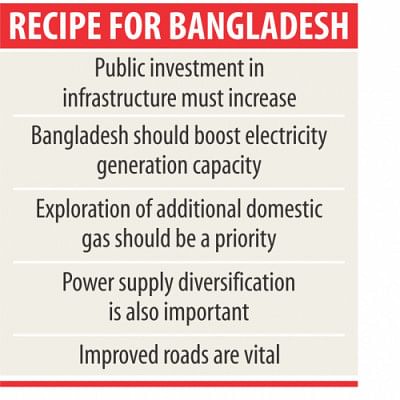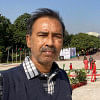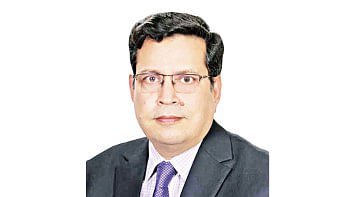WB identifies 5 key areas for growth

The World Bank has identified five key areas where concerted efforts over the next 3-5 years could lead to creation of more and better jobs.
The five areas are: inland connectivity and logistics, energy, regional and global integration, urbanisation and delta management.
Bangladesh has largely neglected investment in infrastructure, the WB said in a report -- "A Systematic Country Diagnostic".
Public investment in infrastructure was less than 2 percent of the gross domestic product, and it lags far behind its regional competitors in infrastructure quality, it said.
Total investment in hard infrastructure in China, Thailand and Vietnam exceeded 7 percent of their GDPs.
To attain 7.5-8 percent growth, Bangladesh will require investment of at least 33 percent of GDP and an increase in infrastructure investments to around 10 percent of GDP per year, according to a WB estimate.
The suggestions came in the 200-page report which identifies key priorities for Bangladesh to reduce extreme poverty and boost shared prosperity.
“This report goes beyond presenting just a diagnostic per se, and also includes a number of recommendations and suggestions on how best to tackle these challenges,” said the WB, the Washington-based multilateral lender.
The report has already been sent to the government and the WB will finance Bangladesh's development over the next five years on the basis of the priorities set in the report, said a finance ministry official.
About the energy sector, the WB said even though electricity generation capacity has doubled since 2009, Bangladesh continues to face significant power shortages.
Only 60 percent of the population had access to electricity, and per-capita electricity consumption of 294 kWh per year was one of the lowest in the world, the report said.
In the light of these facts, the availability and reliability of power is a key concern for businesses.
Surveyed on 15 factors that comprise the business environment, Bangladeshi firms rated electricity as the second highest constraint to their operations, after political instability and ahead of finance and corruption.
More specifically, 28 percent of the firms surveyed identify electricity as their top obstacle and 52 percent identify it as a major constraint to doing business.
Gas is critical for the power sector in Bangladesh, since it fuels 70 percent of generation, according to the report.
However, the WB estimates suggest that domestic gas production will peak at 3,000 mmcfd in 2017 and then begin to decline.
Exploration of additional domestic gas is now a priority, particularly offshore.
In the meantime, liquefied natural gas imports will likely be required soon to fuel existing gas-fired plants as well as those under construction.
Given Bangladesh's over reliance on natural gas, power supply diversification is also a key need.
The other issues facing the power sector are: the dual challenge of massive investment in new capacity while simultaneously facing increasing supply costs.
About inland connectivity and logistics, the WB said Bangladesh needs to accelerate the economic transformation of its rural areas and improving connectivity is the key.
Improved inland connectivity raised agriculture productivity, promoted the movement of the workforce from farm to non-farm employment and reduced poverty, the report said.
Rural road investments have reduced poverty significantly through higher agricultural production, higher wages, lower input and transportation costs and higher output prices, data shows. So it is important to develop and maintain the roads and further integrate them with the larger transport network, the WB said.
“In particular, Bangladesh needs to move away from the 'build, neglect, rebuild' mindset, and instead ensure enough funding is available for maintenance.”
In addition to investments in rural roads, the country also needs to improve east-west connectivity, particularly connecting the southwest to Dhaka.
The report also said Bangladesh can enhance its international competitive edge by improving logistics.
The WB emphasised increasing the capacity of Chittagong port, the Dhaka-Chittagong highway for reducing trade costs.
“Bangladesh should improve physical connectivity with India, but priority should be to remove the policy constraints to seamless cross-border movement of cargo.”
About regional and global integration, the WB said export-led growth has served Bangladesh well.
But there remains significant potential for further expansion in areas such as higher-value garment, pharmaceutical products, non-leather footwear and information technology, the WB said.
On urbanisation and delta management, the WB projected various aspects of Bangladesh.
Urban population growth in Bangladesh has recently been faster than in most other South Asian countries. Employment opportunities are the most important attraction for incoming migrants from rural areas and other smaller urban settlements, according to the report.

 For all latest news, follow The Daily Star's Google News channel.
For all latest news, follow The Daily Star's Google News channel. 



Comments